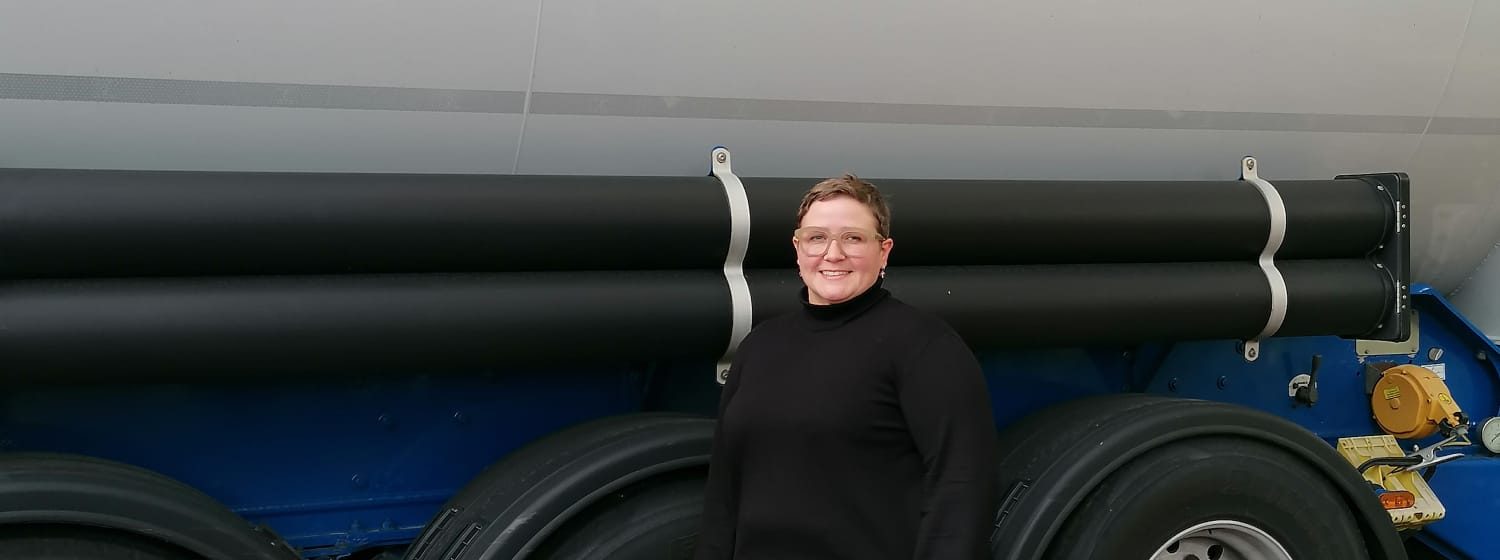
Gwenny Goossens grew up in a transport company and still regularly gets behind the wheel herself, which makes it easy for her to empathise with the world of the truck driver. Since September, she has been teaching road transport to adults.
How did you end up in the transport sector?
Gwenny Goossens (GG): “Everyone in our family is in transport. My husband is managing director at Malenstein Global Logistics. My parents had a transport company in Aarschot, P&W Goossens. The business is now run by my two brothers. So the choice to study logistics management and forwarding was obvious. If you have a bad day, everyone in our family immediately understands why. And it really is a fascinating world. I myself am a jack-of-all-trades and still regularly get behind the wheel of one of our trucks myself to take away a chassis, for instance.”
“I have been working at Schmidt Belgium, a division of Karl Schmidt Spedition, Germany’s largest bulk transporter, for three years now. Karl Schmidt Spedition employs 2,500 people in 49 different European offices. We have just under 1,000 trucks on the road and 6,500 containers of our own. In Belgium, we have three branches. I myself work in Wommelgem. In Antwerp, we still have a branch in Port 550 and in-house at INEOS Styrolution on the BASF sites.”
What exactly do you do at Karl Schmidt?
GG: “I am transport manager for Schmidt Belgium in Wommelgem, the first foreign branch for Karl Schmidt, where I take care of everything to do with our drivers. Among other things, I look after the transport planning team, training, safety and quality control. I also do all the audits and make price calculations. In addition, a lot of general tasks are added.”
Everyone talks about the great lack of drivers. What is the situation with you guys?
GG: “With us, all trucks are manned. You really have to cherish and value your drivers, it’s incredibly important. You have to grab good applicants immediately, stop unloading them and help them on board. The profession often comes out in a negative way. If something is repeated often enough, people eventually believe it. And it really is a very beautiful profession, but the absolute lack of respect and tolerance do not make it easy for us. In some provinces, there really is a boycott against trucks. Due to overregulation, you are hardly allowed to pass anywhere.”
“There is also the ageing population and too little influx of new drivers. These are all things that do not contribute to the image of the truck driver. The war in Ukraine is also causing fewer available drivers. Many Ukrainians have been called up to fight in their motherland while their trucks are sidelined here. We then have to restaff those with drivers we would have preferred to put on another truck.”
What makes someone a good driver?
GG: “A good driver must exude gusto. They must be willing to think, think ahead, they had to see opportunities and have an eye for accuracy and safety.”
You have also started working as a lateral entrant in provincial adult education since September …
GG: “True, I started teaching the subjects ‘Road transport -incoterms and transport insurance’ at CVO-Vitant’s ‘Transport and logistics employee’ course in September. I myself used to really enjoy it when you were taught by a teacher who himself had both feet in the field. You really hung on the lips of such a person then.”
Now I am in front of the class myself in Hoboken, every Tuesday evening from 6.30pm to 10pm. That module has already finished and the trainees have started their internships. The training itself takes one and a half years. Because I also drive the truck myself, I can perfectly explain to them what it’s like in practice. What should they pay attention to and what are possible pitfalls. We notice that students often lack practical knowledge. That is why I wanted to do my bit, because they are the future of the sector.”

